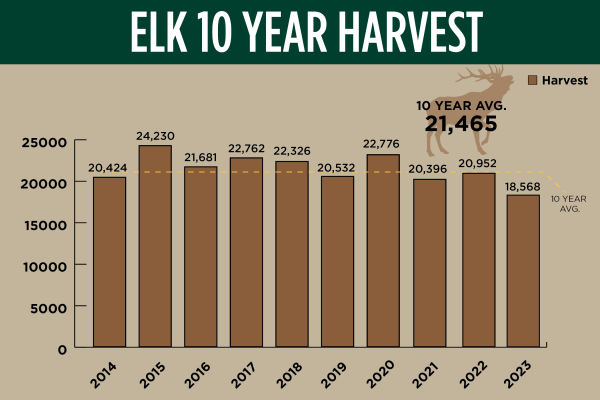Michigan continues to battle chronic wasting disease
The discovery of an eighth free-ranging Michigan white-tailed deer with chronic wasting disease this summer was a disappointment to Michigan Department of Natural Resources wildlife officials.
However, DNR deer and elk specialist Chad Stewart said there was a little bit of good news associated with that discovery.
“DNA testing showed that the latest infected deer was related to four of the other previously identified infected deer,” Stewart said. “So far, all eight have been related to each other somehow, most very closely.
“The overall numbers are still very low, so we’re optimistic we can have some success in keeping this disease confined to a relatively small geographic area.”
Michigan’s first brush with CWD – an always fatal neurological disorder that infects members of the deer family – occurred in 2008 when an infected 3-year-old doe was discovered in a captive deer facility in the southwestern Lower Peninsula.
That facility was depopulated and none of those deer tested positive for the disease.
The disease was next confirmed in May of 2015, when a 6-year-old free-ranging doe was killed in Ingham County. The deer, which was exhibiting signs of CWD, was dispatched by local law enforcement.
“It displayed everything associated with CWD,” said Chad Fedewa, the DNR wildlife biologist who covers Ingham County. “It was extremely emaciated, showed neurological symptoms, and had no fear of humans. People reported seeing this deer to local law enforcement, they put it down, and upon testing, she came up positive.”
The DNR had been ready for such an occurrence.
“We knew at some point we might be faced with combatting chronic wasting disease in Michigan’s free-ranging deer,” said Kelly Straka, DNR wildlife health section supervisor. “Our CWD management plan outlines our surveillance and response actions.”
The DNR enlisted the help of the U.S. Department of Agriculture’s Wildlife Services for deer removal in the township. Of the deer harvested, two more turned up positive for CWD.
“If we’d have been closer to hunting season, we’d have just asked the hunters to do it (the killing),” Stewart said. “But we didn’t want to let it go for six months without doing anything about it.”
Over the next several months, the DNR continued to test deer, including road kills , in a nine-township area surrounding Meridian Township (located in Ingham County). No additional deer testing positive for CWD were found.
, in a nine-township area surrounding Meridian Township (located in Ingham County). No additional deer testing positive for CWD were found.
To increase sample numbers, the DNR instituted mandatory testing of all hunter-killed deer taken in those nine townships, which were designated as the CWD Core Area.
“Once the hunting season began, we went through a lot more samples from hunter-harvested deer without finding any (infected animals),” Fedewa said. “We felt pretty good. But in December, we found two positive (infected) deer from southern Clinton County, an area where we hadn’t found them before.”
One of these deer was turned in at a DNR check station as a result of mandatory testing in the CWD Core Area. The second was harvested outside the core area and was turned in voluntarily.
Both deer were not showing any symptoms of CWD and looked perfectly healthy.
USDA sharpshooters then began collecting deer from areas surrounding those positive deer in Clinton County.
“Ultimately we picked up one more positive up there in Clinton County and one more in Meridian Township,” Stewart said.
As a result, the DNR expanded its Core CWD Area to 17 contiguous townships and its CWD Management Zone to include two additional counties – Ionia and Eaton – which abut counties with CWD-positive deer.
A Core CWD Area is determined by plotting a 10-mile radius around the location where a deer positively confirmed with CWD has been found. In addition and at a minimum, any county with a boundary that is intersected by the Core CWD Area radius is included in a CWD Management Zone.
The CWD Management Zone includes Ionia, Clinton, Shiawassee, Ingham and Eaton counties.
Stewart said he remains “cautiously optimistic” that the disease can be contained and, hopefully, eliminated by dramatically reducing the deer population in the CWD Core Area, which is the only strategy that has proven effective when CWD was discovered elsewhere in the United States.
“Certainly, the number of positive animals we found was more than we were hoping for and that they were separated by a total of about 13 to 15 miles across the landscape was disheartening,” Stewart said. “But we’re very comfortable and satisfied by the number of samples we had in the first year. Our hunters did a good job of complying with the new regulations. Our staff did a great job of collecting road kills, and we had good support from landowners allowing us on their property.”
The DNR found eight infected deer out of more than more 5,900 tested from the CWD Management Zone.
“That’s somewhat encouraging. That gives us a reason to continue our aggressive approach,” Straka said. “We’re trying to find and remove all of the CWD-positive animals on the landscape.”
This deer season, hunters in the 17 townships in the core area are required to have their deer tested for CWD.  There are five DNR check stations located within the CWD Core Area. All of these stations will be open seven days a week during the archery, firearm and muzzleloader deer hunting seasons.
There are five DNR check stations located within the CWD Core Area. All of these stations will be open seven days a week during the archery, firearm and muzzleloader deer hunting seasons.
The DNR is issuing disease control permits to any landowner with at least 5 acres in the CWD Core Area and offering damage control permits elsewhere in the CWD Management Zone.
“Last year when we found CWD, we opened early antlerless deer hunting in the original three counties of the CWD Management Zone (Ingham, Shiawassee and Clinton),” Stewart said. “This year, we added the two additional counties, Ionia and Eaton, to the early-antlerless season.”
Baiting and feeding of deer is not allowed in the five-county CWD Management Zone to avoid unnaturally concentrating deer in these areas. Antler restrictions on the second-buck tag have been removed in the CWD Core Area in an effort to improve hunter success.
Unlike most wildlife diseases, CWD is not caused by bacteria or virus, but rather by prions – mutated proteins. Animals can pass those prions through feces or bodily fluids (urine or saliva) and prions have been found to persist in the soil for extended periods of time.
The DNR is not speculating on how the Meridian Township deer were exposed to CWD, though careless disposal of a carcass of an infected animal is a potential means.
Hunters are reminded that they may not bring anything home to Michigan but boned-out meat, antlers and the cape of animals taken in states where CWD has been found.
CWD has never been linked to humans, pets or livestock. It has been found in deer, elk, and moose in the United States and Canada and was recently detected in reindeer in Norway.
The DNR has been conducting town hall meetings in areas where CWD-positive animals have been found, and has dispensed a great deal of information about the disease and the elimination strategy.
In the Upper Peninsula, a campaign to “Keep the U.P. CWD free” was initiated in fall 2015 and is continuing.
The information and education campaign – which has included billboards, information sheets, bumper stickers and other efforts – is designed to educate the public about the disease and the importance of keeping CWD from spreading into Upper Michigan from Wisconsin or other states.
This year, the DNR has been testing deer from counties in the U.P. closest to the Michigan-Wisconsin border. No infected deer have been found. The DNR has agreed to test any deer that hunters submit for disease testing.
For more information on CWD, visit www.michigan.gov/cwd.
Catch upcoming stories by subscribing to free, weekly “Showcasing the DNR” articles. Check out previous Showcasing articles.






